
Nuoro is a city and comune (municipality) in central-eastern Sardinia, Italy, situated on the slopes of the Monte Ortobene. It is the capital of the province of Nuoro. With a population of 36,347 (2011), it is the sixth-largest city in Sardinia.
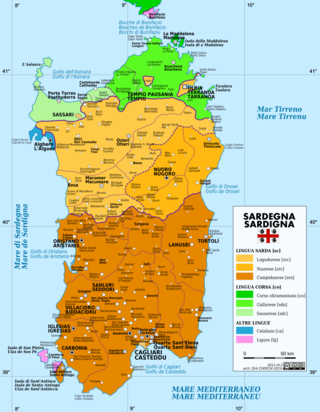
Logudorese Sardinian is one of the two written standards of the Sardinian language, which is often considered one of the most, if not the most conservative of all Romance languages. The orthography is based on the spoken dialects of central northern Sardinia, identified by certain attributes which are not found, or found to a lesser degree, among the Sardinian dialects centered on the other written form, Campidanese. Its ISO 639-3 code is src.
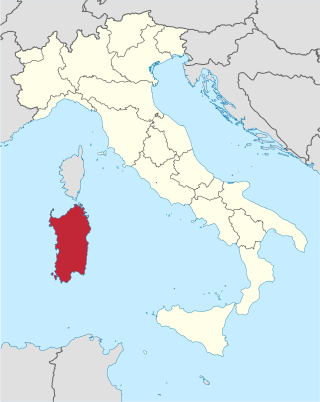
Sardinia is the second-largest island in the Mediterranean Sea, after Sicily, and one of the 20 regions of Italy. It is located west of the Italian Peninsula, north of Tunisia and immediately south of the French island of Corsica.

Cagliari is an Italian municipality and the capital of the island of Sardinia, an autonomous region of Italy. Cagliari's Sardinian name Casteddu means castle. It has about 155,000 inhabitants, while its metropolitan city has about 420,000 inhabitants. According to Eurostat, the population of the Functional urban area, the commuting zone of Cagliari, rises to 476,975. Cagliari is the 26th largest city in Italy and the largest city on the island of Sardinia.
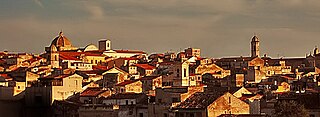
Sassari is an Italian city and the second-largest of Sardinia in terms of population with 127,525 inhabitants, and a Functional Urban Area of about 260,000 inhabitants. One of the oldest cities on the island, it contains a considerable collection of art.
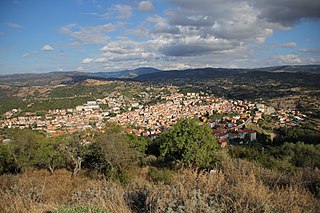
Ozieri is a town and comune of approximatively 11,000 inhabitants in the province of Sassari, northern Sardinia (Italy), in the Logudoro historical region.

Archaeological evidence of prehistoric human settlement on the island of Sardinia is present in the form of nuraghes and other prehistoric monuments, which dot the land. The recorded history of Sardinia begins with its contacts with the various people who sought to dominate western Mediterranean trade in classical antiquity: Phoenicians, Punics and Romans. Initially under the political and economic alliance with the Phoenician cities, it was partly conquered by Carthage in the late 6th century BC and then entirely by Rome after the First Punic War. The island was included for centuries in the Roman province of Sardinia and Corsica, which would be incorporated into the diocese of Italia suburbicaria in 3rd and 4th centuries.
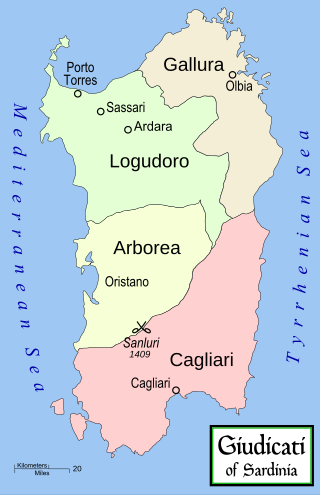
The Judicates, in English also referred to as Sardinian Kingdoms, Sardinian Judgedoms or Judicatures, were independent states that took power in Sardinia in the Middle Ages, between the ninth and fifteenth centuries. They were sovereign states with summa potestas, each with a ruler called judge, with the powers of a king.

The province of Sassari is a province in the autonomous island region of Sardinia in Italy. Its capital is the city of Sassari. As of 2017, the province had a population of 493,357 inhabitants.

Giovanni Maria Angioy was a Sardinian politician and patriot and is considered to be a national hero by Sardinian nationalists. Although best known for his political activities, Angioy was a university lecturer, a judge for the Reale Udienza, an entrepreneur and a banker.

The Judicate of Arborea or the Kingdom of Arborea was one of the four independent judicates into which the island of Sardinia was divided in the Middle Ages. It occupied the central-west portion of the island, wedged between Logudoro to the north and east, Cagliari to the south and east, and the Mediterranean Sea to the west. To the north east and beyond Logudoro was located Gallura, with which Arborea had far less interaction. Arborea outlasted her neighbours, surviving well into the 15th century. The earliest known judicial seat was Tharros. The Judicate of Arborea at the times of its maximum expansion occupied the whole island's territory, except the cities of Alghero and Cagliari.

The Judicate of Logudoro or Torres was a state in northwest Sardinia from the tenth through the thirteenth century. Its original capital was Porto Torres. The region is still called Logudoro today.

The Judicate of Cagliari was one of the four Sardinian judicates of the Middle Ages, kingdoms of Byzantine origins.

The Judicate of Gallura was one of four Sardinian judicates in the Middle Ages. These were independent states whose rulers bore the title iudex, judge. Gallura, a name which comes from gallus, meaning rooster (cock), was subdivided into ten curatoriae governed by curatores under the judge. In the 13th century, the arms of Gallura contained a rooster.

Marianus II was the Judge of Arborea from 1241 to his death. With skilled military action, he came to control more than half of the island of Sardinia. By his control of the vast central plains and the rich deposits of precious metals, he increased the riches of his Judicate and staved off the general economic decline affecting the rest of Europe at the time.

The Kingdom of Sardinia, also referred to as the Kingdom ofSardinia-Piedmont or Piedmont-Sardinia during the Savoyard period, was a state in Southern Europe from the early 14th until the mid-19th century.

The Sardinians, or Sards, are a Romance language-speaking ethnic group native to Sardinia, from which the western Mediterranean island and autonomous region of Italy derives its name.
This article presents a history of Cagliari, an Italian municipality and the capital city of the island of Sardinia. The city has been continuously inhabited since at least the neo-lithic period. Due to its strategic location in the Mediterranean and natural harbor, the city was prized and highly sought after by a number of Mediterranean empires and cultures.

The Free Municipality of Sassari or Republic of Sassari was a state in the region of Sassari in Sardinia during the 13th and 14th centuries, confederated first with the Republic of Pisa as a semi-autonomous subject and later with the Republic of Genoa as a nominally independent ally. It was the first and only independent city-state of Sardinia during the early renaissance.
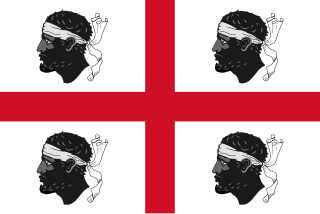
The Kingdom of Sardinia, was a feudal state in Southern Europe created in the early 14 century and a possession of the Crown of Aragon first and then of the Spanish Empire.






















